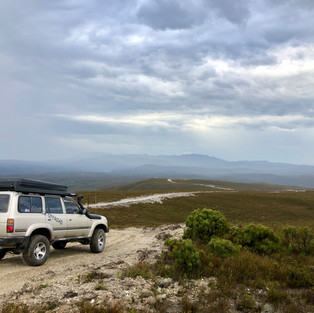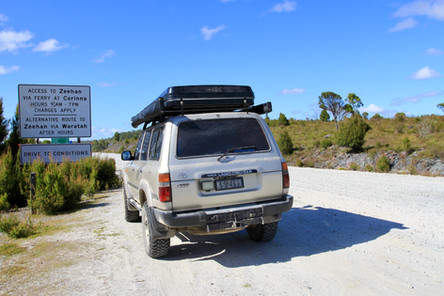WESTERN EXPLORER TRAIL ... Tassie
- Woolgoolgaoffroad
- Jul 22, 2020
- 6 min read
The contrast of Tasmania’s west coast to the rest of the island needs to be seen to be believed where it’s often wet and cold but its the perfect place to get out of your comfort zone. The wild west as its regarded is open to the western squalls off the open oceans where the next piece of land is literally tens of thousands of miles away. But it's out here where you can explore till your hearts content in remote areas, track along some great touring trails, explore the history and get lost in some of the most awe inspiring scenery the island has to offer.

Theres lots of debate on who actually discovered or sailed down along the west coast but it was in 1827 when a skilled bushman and surveyor by the name of Henry Hellyer trekked across the island and reached Arthur River naming it after the governor at the time. These days a plaque on the coast declares this place as ‘The end of the world’ due to the prevailing blustery and at times icy winds from the gale force roaring forties. Arthur River is the western most town on the island and it wasn’t until 50 odd years ago that the town was so isolated that no serviceable roads were connected and the only way in and out was by air, rail or the treacherous ocean.
One way to explore this remote region is to head south from Arthur River along Temma Road to the start of the Western Explorer Road after restocking at Arthur River. Part of the Tarkine region, the Western Explorer road meanders through an array of different landscapes plus cuts through the world largest remaining piece of temperate rainforest where high rainfall and cool weather has created diverse and stunning areas. Always looking for a side track, keep an eye out for the turn out to Couta Rocks, this is true west coast ruggedness with sweeping ocean views along the rocky coastline. Lighthouses dot the coastline.

This touring trail can be tackled by most SUV but it's the side diversions where you’ll need a decent 4wd to tackle the bog holes, mountain ridge climbs or attempt any of the wild beach drives. Most of the hard core action drives along here do state that you’ll need to travel in convoy, be experienced and have recovery gear, its pretty serious stuff.
At the start of the Western Explorer Road ( WER ) a viewing area across the button grass plains with history boards and road information signs is where you can get a little insight on the area and what to expect. Signs suggest that the drive can take just a couple of hours but trust me you won’t see much if you don’t get off the main road. For the first part of the drive its Button Grass plains with a contrast of coastal Tea Tree that dominate the area due to the wet swampy black marsh lands.
One of the first stops is at the iconic Balfour Track which is a pretty serious Tassie 4wd trail where attempting it solo isn’t a smart move. From the warning sign the mud holes are long and deep and the side trails look no easier either, but across the road there’s a couple of 4wd tracks towards the old town of Balfour. Originally mined for copper, tin and iron pyrite its now a rundown area that was abandoned just before WW1 where mine relics and the mines, a few headstones and building foundations are all that exists now.

The WER was a surprise with its stark white gravel base, yet off to the sides the ground was like a black peat base, but when the Norfolk Range came into view there were stands of huge Eucalypt trees that were blackened due to recent fires. As the road wound its way around the range, mountains towered over the landscape with Mount Edith standing higher than the others at 740m high yet on the eastern side of the Explorer road the Badger Plains faded into the distance towards the centre of Tassie. Part of the mighty Tarkine Wilderness this vast area is being preserved for the future with a huge range of either threatened or endangered plants and animals.
Heading down further south crossing the Savage River the whole environment changes into thick near impenetrable forest areas. In fact when the early explorers were trekking through the area they called this ‘savage country’ due to the interlocking branches and trees. The sun doesn’t penetrate the ground through here and is constantly damp but this allows for thick carpets of moss to grow over everything. The rivers aren’t clear out here but are coloured like weak tea because of the tannin leeching out of the button grass plains.

Through the forest water races were used to provide a constant flow of water to the mines and it was in 1883 that Tasmania’s largest gold nugget weighing in at 7kg was found. Corinna goldfields were that remote that supplies were bought in by boat on the SS Dorset for many years and they took out Huon pine for the export market. Life out here revolved around mining and drinking and with a hotel on either side of the river a punt was used to frequent the two. But when the owner of the Star hotel passed away many miners drowned trying to cross the river for the burial as not many were sober, the night was full of brawls until the police shut the town down.

Today the punt has been replaced by a car ferry but only operates in daylight hours. Around town there’s a few walks along the river and into the wilderness, the graves track, or simply just enjoy a beer at the Corinna Hotel which is packed with memorabilia from the past 100 years. If by some chance you miss the ferry like I did, take the chance to head further east to Waratah just an hour away along Corinna Road. Winding through thick scrub in the West Plain region it wasn’t long before I entered the Savage River mining area. This is no ordinary town as it was built for the workers who operate the huge Iron Ore mine around the town. Discovered in 1877 it has operated ever since and now a pipeline connects the mine to Burnie, 100km for export. The iron ore is pelletised for its journey through the pipe and onto the ships.

Further down the road at Waratah this sleepy village holds some pretty interesting history. Once laying claim to having the largest Tin mine in the world there’s a few cool things to explore in the town. Just on the outskirts of Waratah a good natural wonder is Philosopher’s Falls that James Smith discovered in 1871 when he was looking for new areas to prospect in and finding Tin nearby the boom was on at Mt Bischoff.

The walk down into Philosopher’s falls is nothing short of stunning where tall tree ferns and moss covered trees line the path. Water races were used in this area too and its pretty amazing to see just how they were hand cut as you follow them along. When they were dug, a worker was commissioned to walk them daily to ensure there was a constant flow of water and no obstructions along the way.

Getting the tin out of the area was done by a horse drawn trolley on a timber tramline until the railway was built in 1884. Another feat that Mt Bischoff mine had was it was the first in Australia to be run by hydro electricity. Soon after St James’s church in Waratah was the first church in Tassie to be lit by electricity.

Today Waratah is like a step back in time where building have been restored to their former glory, a heritage walk around town and plenty of mine relics to explore in the town. A working water wheel still operates today at the top of Waratah Falls in the heart of town and across the road a kids playground has been designed from old mining gear including several carts, half a water wheel and a trommel ( like a huge tumbler to seperate material ).
A main attraction is the Kenworthy Stamper mill which was owned and run by Dudley Kenworthy who used it until he passed away. The mill setup was bought and it was meticulously pulled apart, transported and set up exactly the way it was at Mt Bischoff all under a huge new shed. With a gold coin donation visitors can enter the shed and with the push of a button the stamper fires up, the shaker works just like the way it was used back in its working day.

The Waratah museum has a stack of old photos and memorabilia just like the mock up hut next door to simulate the one that James Smith lived in when mining in Waratah. Up the road the 100 year old Bischoff Hotel still operates, while not the true original as the first two burnt down but were built hastily due to the miners thirst. Other spots to check out are the water tunnels just on the edge of town where huge amounts of water were diverted from the swamps to the mine for the stampers, this area receives nearly 2 metres of rainfall each year.
The west coast is a unique, ruggered and of course a stunning area, but to truly understand the area I highly recommend just to slow down and explore the little towns. Theres no where else in the world like the west coast of Tasmania.













































Comments